Episode 155: STS-77 - Wacky Waving Inflatable Arm-Flailing Tube Satellite (IAE, PAMS, SPACEHAB)
Table of Contents
On STS-77 we’ve got some experimental technology to try out that if nothing else lead to some pretty wild visuals. We’ll also get some work done on SPACEHAB and wonder why Marc Garneau loves hanging out with Australians so much.
Episode Audio #
Photos #
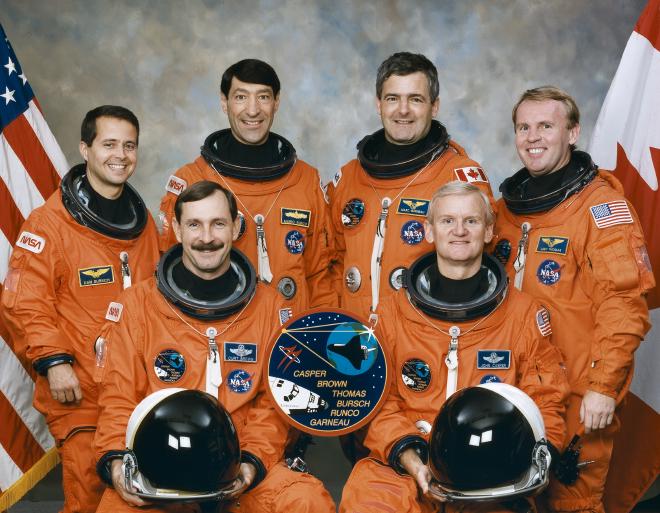
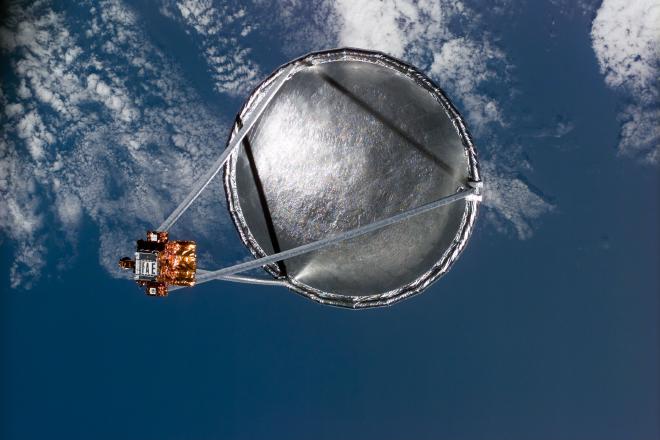
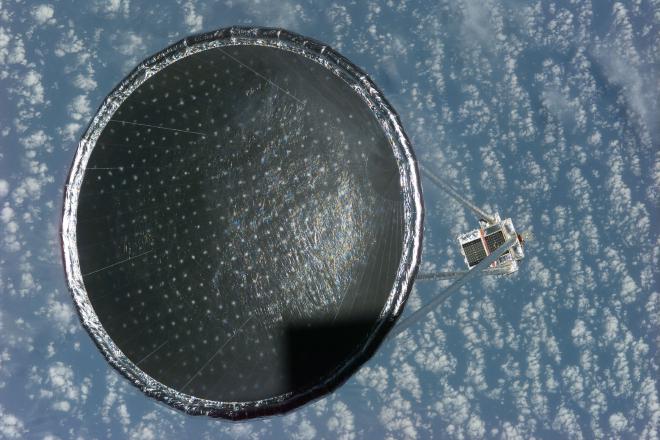
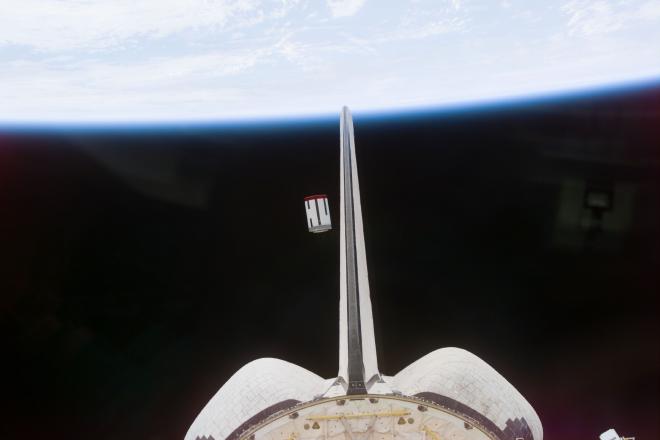
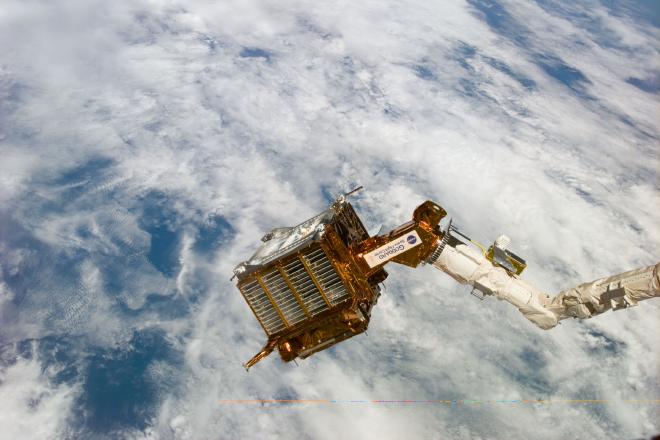
Mission Highlights Resources Tape #
Want a whole lot of B-roll from the mission? Well you are in luck because here’s the mission highlights resources tape.
IAE Deployment Video #
If you just want to see the part of the mission highlights resources tape with the IAE deployment, this copy of the video will start at the right time. Note that if you want to see it in approximately realtime you should change the video speed to 0.5x.
Post-Flight Presentation #
Transcript #
NOTE: This transcript was made by me just copying and pasting the script that I read to make the podcast. I often tweak the phrasing on the fly and then forget to update the script, so this is not guaranteed to align perfectly with the episode audio, but it should be pretty close. Also, since these are really only intended to be read by myself, I might use some funky punctuation to help remind myself how I want a sentence to flow, so don’t look to these as a grammar reference. If you notice any egregious transcription errors or notes to myself that I neglected to remove, feel free to let me know and I’ll fix it.
Hello, and welcome to The Space Above Us. Episode 155. Space Shuttle flight 77, STS-77: Wacky Waving Inflatable Arm-Flailing Tube Satellite
Last time, we sat down with our old friend, former astronaut Dan Tani. Rather than talking about the marvels of spaceflight, we focused on what the process of applying to be an astronaut was like as well as the day to day work of an astronaut who has yet to be assigned to a mission. As usual, we learned a ton from Dan and it was great to finally get to interview him in person.
The timing of the interview was no accident. During Shannon Lucid’s stay on Mir, and before the mission we’ll be covering today, NASA introduced the largest class of astronauts in its history: the 44 men and women of Astronaut Group 16, aka The Sardines. Full disclosure on this one, since the stakes are pretty low and tracking down all the announcements of the main group and the individual international mission specialists would be a hassle, I’m gonna do something I never do without a heads up and just rely on the Wikipedia page for this list. Also, as usual, I’m just gonna do my best on pronunciation here rather than tracking each person’s name down, so if I really biff one up, it’s a perfect opportunity for you to email a correction to jp@thespaceabove.us. Anyway, let’s meet The Sardines.
First, the pilots:
Duane Carey, Stephen Frick, Charles Hobaugh, James Kelly, Mark Kelly (no relation), Scott Kelly (super relation, he and Mark are actually identical twins), Paul Lockhart, Christopher Loria, William McCool, and Mark Polansky.
And the mission specialists:
David Brown, Daniel Burbank, Yvonne Cagle, Frank Caldeiro, Charles Camarda, Laurel Clark, Michael Fincke, Patrick Forrester, John Herrington, Joan Higginbotham, Sandra Magnus, Michael Massamino, Richard Mastracchio, Lee Morin, Lisa Nowak, Donald Pettit, John Phillips, Paul Richards, Piers Sellers, Heidemarie Stefanyshyn-Piper, Daniel Tani, Rex Walheim, Peggy Whitson, Jeffrey Williams, and Stephanie Wilson.
We also have nine international mission specialists. This is where I really get in trouble with pronunciation.
Pedro Duque from Spain, Christer Fuglesang from Sweden, Umberto Guidoni from Italy, Steven MacLean from Canada, Mamoru Mohri from Japan, Soichi Noguchi from Japan, Julie Payette from Canada, Phillipe Perrin from France, and Gerhard Thiele from Germany.
If a few of those international mission specialists sounded familiar it’s because Guidoni, MacLean, and Mohri all previously flew as Payload Specialists.
But in general, if you’ve been keeping up with spaceflight over the last decade or two, a lot of these names will sound pretty familiar. Sandy Magnus and Rex Walheim flew on the last ever shuttle mission. Lisa Nowak.. well, made national news. Mike Massamino famously, and with permission, tore a handle off of the Hubble Space Telescope. Scott Kelly spent nearly a full year on the ISS in a well-publicized experiment. And of course, William McCool, Mike Brown, and Laurel Clark were all lost along with Space Shuttle Columbia on STS-107.
All but two people on this list flew at least once, with most flying more than that. And normally this is where I’d mention who went the distance with the latest mission, but we’re bumping up close enough to the present day that it doesn’t really work anymore. Don Pettit is still an active astronaut with NASA, and Peggy Whitson is scheduled to command a mission for the private spaceflight company Axiom some time in 2023.
So welcome to the stage, Sardines. It’s a pleasure to be flying with you.
But now, it’s time to turn our attention back to 1996. Between the Mir flight and the Tani interview it feels like it’s been a while since we did a regular space shuttle mission, but a regular space shuttle mission is what we have. On this flight, Space Shuttle Endeavour will set some new milestones with regards to rendezvous, we’ll inflate the world’s most expensive bounce house, and of course, we’ll grow some crystals. Let’s meet the crew. (Oh good, more names to remember!)
Commanding the flight is John Casper, who we last saw easing Space Shuttle Columbia down onto the runway after nearly 14 days in space on STS-62, carrying US Microgravity Payload 2. He won’t be bumping up against any long duration records this time, but he will have his work cut out for him with more stationkeeping than on any previous shuttle flight. This is Casper’s fourth and final flight, having first flown back on STS-36.
Flying alongside Casper is today’s Pilot, Curt Brown. When we last saw Brown he was piloting Atlantis on STS-66. On that flight we flew the final ATLAS payload, along with the CRISTA-SPAS free-flying experiment. Today marks his third flight and he’s got three more to go.
Sitting behind Brown on the flight deck during ascent was Mission Specialist 1, the mission’s Payload Commander, and our lone rookie for today’s flight, Andrew Thomas. Andrew Thomas was born on December 18th, 1951 in Adelaide, South Australia. Thomas earned a Bachelor’s degree and a Doctorate in Mechanical Engineering, both from the University of Adelaide. Thomas had his sights set on flying in orbit from a young age, which, as he has pointed out, was gonna be a tricky thing to accomplish as an Australian. As we’ve learned, Australia has more of a space program than some people might think, but flying people in space was not their forte. With that in mind, Thomas became a research scientist with Lockheed, working on fluid dynamic instabilities and aircraft drag. He worked his way up through several high level research positions before heading out to the Jet Propulsion Laboratory to head up their microgravity materials processing department. Along the way, he recited the oath and became a citizen of the United States. Between the American citizenship and working for NASA at JPL, Thomas was clearly on the right path, and in 1992 he was selected as an astronaut. This is his first of four flights, including a lengthy stay on Mir. I hope he likes Jello.
Sitting to the Australian-slash-American’s left was Mission Specialist 2, Dan Bursch. As Ben Evans points out in his book The Twenty-First Century in Space, Bursch’s two previous flights both encountered an always-scary RSLS abort. That is, the main engines lit.. and then the computer changed its mind and decided not to go to space that day. Well, good news for Dan, today’s flight will be smooth sailing. This is this third of four missions.
Moving downstairs, we find Mission Specialist 3, Mario Runco. When we last saw Runco he was tooling around in the payload bay helping to evaluate EVA techniques on STS-54, after successfully deploying the TDRS-F communications satellite. This marks Runco’s third and final flight.
And last but certainly not least, a blast from the past, Mission Specialist 4, Marc Garneau. You might be forgiven if Marc Garneau had slipped your mind, though I’m sure I can think of two listeners in particular who are yelling right now “no he has not!” That’s because on Marc Garneau’s previous flight he became the first Canadian to fly in space. The reason I say you might be forgiven for not having that name at the top of your mind is that that flight was STS-41G, twelve years earlier in 1984. To refresh your memory, STS-41G was the 13th space shuttle flight and deployed the Earth Radiation Budget Satellite. I don’t mean to pick on poor Marc Garneau who clearly had to wait a long time for this flight, but it was just so crazy reminding myself what happened on STS-41G. On that mission they launched in fabric flight suits, the flight engineer was Sally Ride, and the mission commander was Bob Crippen. Weirdly enough, STS-41G also featured an Australian crew member, Payload Specialist Paul Scully-Power. In fact, Garneau has flown with 100% of the Australians who have flown in orbit. Yet another bit of esoteric trivia to rattle around in your brain. In any case, we’re glad to have Garneau back as a full Mission Specialist and he’s got one more flight to go.
Endeavour and its crew sailed through an uneventful countdown with no scrubs or delays. At 6:30 am local time on May 19th, 1996, Space Shuttle Endeavour lifted off for the 11th time. Notably, when Endeavour cleared the tower and Mission Control Houston took responsibility for the flight, it was in a brand new control room. The entire flight would be controlled from the new White Flight Control Room, or “flicker”. And for another notable milestone, remember those new Block 1 engines that I mentioned flying for the first time a few flights back? Well STS-77 has the honor of being the first mission to use the new design for all three engines. All three main engines did their job and Endeavour was soon inserted into a nominal orbit.
The early part of the mission was dominated by a familiar golden box located right in the middle of the payload bay: SPARTAN-207. SPARTAN is one of my favorite shuttle frequent fliers. It’s a big box about the size of a small car and covered in crinkly gold foil. It also has one of the best worst acronyms: Shuttle Pointed Autonomous Research Tool for Astronomy. Typically, as the name suggests, SPARTAN plays host to a number of different astronomy-related instruments. By taking advantage of the capabilities of the space shuttle, the SPARTAN designers could strip out a number of systems that a typical satellite requires. No need for propulsion since the shuttle would drop it off in the correct orbit. No need for communications because the experiment sequence could be programmed into the onboard computers and the data could later be downloaded once the shuttle picked it back up again. No need to ensure that things would last for multiple years since each deployment only lasted a handful of days. It’s a pretty nifty device.
Today, we’ll be taking advantage of this nifty little device in a new way. Rather than using it to study the cosmos, we’ll be using it to safely study some new space technology. It’s time to meet the Inflatable Antenna Experiment.
I’m sure you can guess a lot about where I’m going with this just based on the name of the experiment, but as is often the case with NASA activities, the bland title belies the complexity and audacity of the experiment we’re about to see.
Let’s play a game of “why”s. Why are satellites so expensive? Well, a number of reasons, but one is that they’re typically really complicated. Why? Again, a number of reasons, but one is that they have to fold up to fit inside the small volume available inside a launch vehicle. Why? Because satellites often require large solar arrays, antennas, and booms in order to correctly do their jobs and rockets are relatively small. Why are those deployments complicated? Because you usually only get one shot and there’s usually not anybody around to help fix a deployment that goes wrong. Whether it’s from sitting around too long in a cleanroom, too many trips across the country on a flatbed truck, some worn-out grease, an unexpected temperature gradient, or a sticky latch, there are a lot of things that can go wrong when deploying parts of a satellite. So engineers have to spend a ton of time designing the systems to be as robust as possible and then even more time testing them to convince themselves that the systems work.
These deployment mechanisms, and the structures that are deployed, are expensive, error-prone, and heavy. All things you don’t want with a satellite.
If this was an infomercial, that entire previous section would have been black and white images of sad astronauts struggling with failed satellite deployment mechanisms. But now we’re at the part where the astronaut goes “there’s got to be a better way!” and it switches to full color.
The Inflatable Antenna Experiment hoped to be that better way. On Flight Day 2, Mission Specialist Mario Runco operated the Remote Manipulator System and grappled SPARTAN, lifted it up out of the payload bay, and gently let it go. Commander John Casper then eased Endeavour away, stationkeeping at a range of 250 meters directly above SPARTAN, looking down with the Earth in the background.
What happened next was the fakest-looking real space footage I have ever seen. A panel on SPARTAN pops open and a large amount of silvery foil begins to spill out. At first the mass of crinkles and folds seems to have no distinct form, but as it continues to unravel itself some structure becomes clear. There are three longer sections with numerous folds, connecting the golden SPARTAN to a bigger silvery blob of foil. This is already pretty weird, but suddenly, one of the three longer sections begins to whip around as it suddenly inflates, looking like a fire hose that’s suddenly had the water pressure turned on while nobody was holding it in place. After doing its best impression of a wacky waving inflatable tube man, the crinkly connection has now become a cylindrical strut, half a meter across, and 28 meters long. In imperial units that’s 20 inches across and 92 feet long. Just as the first strut finishes settling in and straightening, a second one begins to inflate, rocking the whole structure around again.
Before the third can inflate, the large mass of foil on the other end begins to take shape as a big torus, or donut-shape, begins to form. Stretched across the interior of the donut are two giant circular pieces of foil that also inflate, looking sort of like a flat American football, or a ravioli, or a UFO. The tube of the donut is half a meter across just like the struts, but as it expands, the donut itself is revealed to be 15 meters, or 50 feet, across. Finally, the third strut inflates, adding some stability to the overall structure and to poor SPARTAN which has been whipped around through a series of crazy attitude slews.
When it all settled down, the Inflatable Antenna Experiment looked sort of like a big silvery hot air balloon with a gold-foil basket. But instead of a bunch of short ropes connecting to a tall balloon, it was three fat struts connected to a weirdly squished balloon in the shape of a UFO. It was.. wild. I’m going to be sure to link to a video of this when I post the episode’s announcement tweet, but if you’re listening to this later, you really owe it to yourself to track it down. At the time of this writing, you can go to the YouTube account of NASA STI and search “STS-77 Mission Highlights Resource Tape” and then skip to around 24 minutes and 30 seconds. Though you’ll want to set it to half speed to be close to what the crew actually saw.
Despite the sort of wild dynamics of the deployment, which was actually played out over 5 minutes, the deployment mostly worked. Though it also left the entire structure rotating at a rate of 3 degrees per second, which is pretty fast for most satellites. But suddenly, here we have a big reflective dish about the size of a tennis court, flying through space! Considering that it only weighed about 60 kilograms, fit into a small box stuck to SPARTAN, and apparently only cost around $10 million to develop and build, that’s pretty impressive.
While the crew observed from their stationkeeping point on the plus-R-bar, special lights on SPARTAN shone onto the underside of the antenna to help characterize the surface and how smooth it was. Then only 20 minute after deploying, a circular shockwave rippled across the antenna’s main dish as the jettison pyros were fired and the structure was cast free. The experiment was just to see how the deployment worked out and what quality structure they could get. There was no need to keep it around once that was complete. Less than two days later, thanks to its high drag and low mass, the antenna reentered Earth’s atmosphere and burned up. And actually, that probably explains why they wanted to get rid of it so quickly. The longer SPARTAN held onto IAE, the lower it would drop, which would make things trickier when it came time to pick it back up in a couple days. But since it did get rid of the antenna, that rendezvous and capture went nice and smoothly, with Marc Garneau operating the robot arm to safely retrieve the little satellite.
The Inflatable Antenna Experiment is a pretty wild little corner of spaceflight history that I had never heard of. The mission report that came out a few months after the flight noted that it successfully deployed but that analysis was ongoing. I’ll save the real conclusion of that story for a little later.
Before we get to the next experimental deployable payload, we should probably take a look at what the crew is doing. Taking up the front part of the payload bay was everybody’s favorite flat-topped pressurized module: SPACEHAB. I’ll spare you the full SPACEHAB origin story this time, but this was the commercial competitor to Spacelab that essentially served as an extra room for the shuttle crew. Packed inside SPACEHAB, and for that matter, also in some canisters lining the back wall of the payload bay, were a bunch of little experiments that I will sadly not do justice to today. I can’t help it. With limited time to talk about stuff, you know the sedate science is gonna get pushed back a bit by the orbital velocity bounce house. But let’s at least take a quick tour through what’s going on in SPACEHAB.
The Advanced Separation Process for Organic Materials was looking into better techniques for separating different materials for use in biomedical and pharmaceutical applications. The Commercial Generic Bioprocessing Apparatus held 272 individual experiments studying everything from bacteria and fungus to studying the 3d structure of RNA molecules to assist in designing drugs to combat AIDS. The Plant Generic Bioprocessing Apparatus studied the behavior of plants in microgravity, which somehow let them look at anti-malarial and chemotherapy drugs, as well as spaceflight’s effects on starch, sugar, and fatty acids. The Gas Permeable Polymer Membrane was looking into ways to make the types of polymers required for advanced contact lenses. The Four Handheld Diffusion Test Cell satisfied the 8th law of spaceflight which states that all shuttle flights must include crystals.
Probably the weirdest one was the Fluids Generic Bioprocessing Apparatus-2. This experiment aimed to determine if carbonated beverages could be produced from separately stored carbon dioxide and flavored syrups while not making a bubbling foamy mess. If this sounds an awful lot like how soda is made.. that’s because that’s how soda is made. This experiment was sponsored by Coca-Cola. Also, I’m no expert in this, but I’m pretty sure they’ve been doing that for decades so I’m not sure why they needed to fly this experiment. One part that made more sense to me was that they were hoping to study if microgravity affected the crew’s sense of taste. If I understand correctly, figuring out that microgravity affected taste might give clues into how taste works and how other people with altered senses of taste might be helped. One application touted by the experiment description was specially crafting beverages to help keep elderly people hydrated. So I guess I can’t argue with that.
There were a few other smaller experiments, but the point is that there was more than enough to keep the six person crew busy when they weren’t chasing down things in orbit.
In the back of the payload bay were a number of experiments under the umbrella of something called “Technology Experiments for Advancing Missions in Space” or “TEAMS”. And unlike the Teams chat client that I have to use at work every day to communicate with my coworkers, this one is pretty cool.
There were a few different experiments in TEAMS, including one that immediately caught my eye. The Vented Tank Resupply Experiment sought to demo some technology for transferring fuel into nearly empty tanks of fluid in space. This drew my attention due to my involvement with the OSAM-1 mission (which is what Restore-L was renamed to), but the more immediate motivation was to better understand how to refill propellant tanks on the upcoming ISS. A mostly empty tank will have some blobs of fluid drifting about, along with some vapor of that fluid. If you try to simply refill the tank, that vapor is going to push back and make things difficult. You might open a vent on the other side, allowing the gas to escape, but since we’re in space, there’s nothing stopping a blob of your working fluid from getting squirted right out the vent. That sort of defeats the point of the refill and depending on the fluid it could be dangerous. In this experiment, a specially shaped structure was placed around the vent. Using capillary action, it drew fluid away from the vent, leaving it clear for just vapor to be vented out. It’s sort of the opposite of the problem where you always want propellant to hang around near the thruster intake so the thruster has something to work with. Pretty neat.
There was also an experiment using GPS signals and multiple receivers to try to determine the attitude of the shuttle. By looking at the difference in phase between the different radio signals, the hope was to accurately figure out which way the shuttle was pointed. If it could be made to work, heavier and more expensive attitude determination equipment could be a thing of the past.
And the Liquid Metal Thermal Experiment was the latest in a series of experiments looking at the behavior of heat pipes. But in this case, instead of something closer to room temperature like ammonia, the working fluid was liquid potassium as high as 1000 degree Celsius.
But wait, I promised you more things to chase down in space! The last of the TEAMS experiments was the Passive Aerodynamically Stabilized Magnetically Damped Satellite, or PAMS. The goal here was to try to come up with some technology that would passively stabilize the orientation of a satellite. Passive systems are nice because with an active system you have to figure out how to run it, how to configure it, and what to do if something goes wrong, if there’s even anything to be done. Plus, active control of the attitude of a satellite would require thrusters or reaction wheels or control moment gyroscopes or magnetic torquers or something, some dedicated system that had to be added to the pile.
With PAMS, the tiny satellite was designed with two things that would hopefully keep it pointed in the desired direction. First, similar to a badminton shuttlecock or to a feathered arrow, it had a heavy end and a light end. The heavy end would be less slowed down by the small amount of air present in low Earth orbit, so it would tend to be in the front, dragging the lighter portion of the satellite behind it. When the light part rotated out from behind the heavy part, the air would push it back in place. On top of that, PAMS came equipped with some magnets that would play off of the Earth’s magnetic field to further help stabilize the spacecraft. At least that was the idea.
On flight day 4, with Endeavour’s payload bay facing the Earth, Runco flipped the appropriate switches on the flight deck and the 60 by 90 centimeter cylindrical satellite popped out of a canister mounted near the back of the payload bay. It wasn’t readily apparent to the eye but it was intentionally put into a slow tumble. The pilot crew then maneuvered Endeavour back about 15 kilometers to give PAMS time to settle in. Four and a half hours later they approached within around 600 meters to they could take a look at how it was doing. This would include both visual observations from the crew as well as quantitative observations from an instrument in the payload bay that bounced lasers off the little satellite.
Two problems immediately became apparent. First, PAMS was still tumbling. Second, the Attitude Measurement System in the payload bay was having trouble getting a good lock on PAMS. The crew again backed Endeavour away to give PAMS more time to stabilize. Two days later the crew came back once again in their third orbital rendezvous of the mission. At this point PAMS was sort of stable but still not as good as had been expected. For over six hours the pilot crew stationkept nearby PAMS while the mission specialists documented the dynamics of the little satellite and the Attitude Measurement System.. well.. measured its attitude. At least it tried to. It was still struggling a bit, apparently locking onto something else in the payload bay.
The ground decided to delay the third rendezvous with PAMS by 24 hours to give it more time to stabilize and give the Attitude Measurement System team time to figure out what was going on. For its third and final approach, the pilot crew once again swooped in and set up shop about 500 meters away from PAMS. Over the next seven hours and 45 minutes of stationkeeping they noted that it had settled down quite a bit from earlier and seemed to validate the concept being studied. After a record-setting four total rendezvouses and over 21 total hours of stationkeeping, Endeavour flew off one last time and left PAMS to its passively stable self.
At some point during the flight, after it became clear that the limited onboard resources were being used at a reasonable rate, the Mission Management Team granted the now-routine extra day on orbit. But even with the extra day, it was soon time to come home. Just like the ride uphill, the fiery return to Earth went perfectly smoothly, with no weather delays or other issues. After 10 days, 0 hours, 39 minutes, and 24 seconds, Endeavour was back home in Florida. After it successful mission, Endeavour entered a period of extended maintenance that would include upgrades required for its next mission. Believe it or not, that next mission, only two-and-a-half years away would be the first construction flight for the ISS. Time flies.
This is a neat little mission. In fact, according to shuttle flight director Wayne Hale, it’s his favorite. The fact that it was his first time as lead flight director certainly helped, but I can see why Hale is a big fan. This flight is really emblematic of a lot of what NASA does. It was pushing the boundaries of some new technologies that held the promise of pushing our capabilities in space forward by leaps and bounds. But you know what? Neither of them really worked that great. The Inflatable Antenna Experiment deployment was way more chaotic than expected, and the final shape was too wrinkly to be a really reliable antenna. PAMS sort of worked but even then, it was only stable to within 20 degrees. Which for most applications isn’t really all that useful.
It sounds like I’m dumping on these experiments but I actually think this is super cool. Hale actually wrote about this in his official NASA blog in an entry titled “My Favorite Shuttle Flight” and expressed similar sentiments. The ability to try something bold and daring, not have it work out, but continue on and learn something from it is what it’s all about. Sometimes, in fact most of the time, failure is an option. There aren’t many inflatable structures in space today, but the BEAM module on the ISS is providing extra storage space while looking at how they hold up over time. I’m not sure I’m aware of any passively stabilized satellites, but missions like the Gravity Field and Steady-State Ocean Circulation Explorer actually used aerodynamic forces to help keep it stable while flying at extra low orbital altitudes. Try, fail, learn, try again. That’s something to celebrate.
Next time.. we’ll trade Endeavour for Columbia and SPACEHAB for Spacelab. And we’ll discover a problem that will leave Shannon Lucid in space for another few months. At least she’s got some reading material.
Ad Astra, catch you on the next pass.
